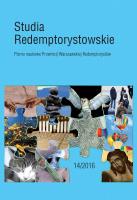Święta czy grzeszna? – kobieta średniowiecza
Holy or sinful? – the medieval woman
Author(s): Jan WiśniewskiSubject(s): Christian Theology and Religion, Gender Studies, Middle Ages, Victimology
Published by: Warszawska Prowincja Redemptorystów
Keywords: Middle Ages; desire for salvation; weaknesses of women; adultery; prostitution; witches;
Summary/Abstract: The life of medieval women was characterized by an inner conflict between the awe and charms of the mundane, material world on the one hand and the ardent desire of salvation on the other hand. This made the woman – continually dependent on her father, brother or husband, succumbing to weakness, with limited opportunity of total devotion to God the Creator (marriage, political activity) – seek to unite with God. The woman was held responsible for sins, scandals, cunning, seducing men, because of the role Eve played in the appearance of the original sin. Later, perceived as a source of the carnal sin, she was considered a seductress, an obstacle on the path to holiness. Although at the end of the Middle Ages, some theologians defended the woman, assuming that since she was the companion in life rather than a slave of the man, it is he who is responsible for the crime, because the woman was subordinated to him. Previously, St. Augustine, whose theology had a strong influence on the Middle Ages, on the example of his of own life, saw promiscuity as a great obstacle to his conversion, which consequently aroused in him feelings of hatred and contempt for the body. Thus he condemned indecency (prostitution, adultery) and dissipated life, also in marriage, and emphasized the importance of innocence and conventual life, as a derivative thereof. This is why these values impressed a strong mark on the sexuality of Christianity in the West. It is worth noting that thanks to God’s grace, the admiration for the beauty of the body and nature can be combined in life with the desire and pursuit for excellence and holiness, that is a union with God, because it was he who created them. In the works of medieval mystics (St. Hildegard of Bingen, St. Clare of Assisi, St. Catherine of Siena, Blessed Dorothea of Montau) the desire to encounter the “Bridegroom” (as in the Blessed Dorothea’s case) is expressed using the language of the senses, with which the woman’s body was recovered from humiliation.
Journal: Studia Redemptorystowskie
- Issue Year: 2017
- Issue No: 15
- Page Range: 409-423
- Page Count: 15
- Language: Polish

